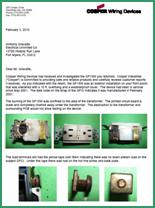Eagle GFCI Analysis
A Follow-up
 On December 30, 2009 we sent out a newsletter titled Eagle GFCI Receptacle Problems in which Anthony requested information from anyone who could help regarding a faulty/burnt GFCI receptacle he discovered in his home.
On December 30, 2009 we sent out a newsletter titled Eagle GFCI Receptacle Problems in which Anthony requested information from anyone who could help regarding a faulty/burnt GFCI receptacle he discovered in his home.
In addition to generating more comments than any other newsletter that month, it caught the attention of Darron Lacey who leads the engineering group for Cooper Wiring Devices and who told Mike:
“My company puts quality as the number one priority. My goal in calling the electrician will be to determine the cause of failure and then respond to your web site in a more definitive manner. “
After the faulty receptacle was sent to Cooper Wiring Devices for analysis, Dan Fielder, Manager of Engineering Services reported on his findings in a letter to Anthony.
Summary: …evidence strongly suggests moisture was involved with this failure. Moisture and contaminates on a printed circuit board can lead to current leakage, carbon tracking and possible arcing. As noted the device was under an overhang and had a weatherproof cover, however moisture infiltration is very difficult to inhibit as it can occur in numerous ways such as wind blown rain, extreme humidity, pressure washing condensation……increasing the importance of keeping GFCIs dry with weatherproof enclosures, proper gaskets and caulking. Click here to read the complete analysis.
Anthony’s comment: I think the industry really needs to address a solution for this problem. Ironically the device is required in locations that are subject to moisture and the presence of a source of water. In southwest Florida where our humidity averages somewhere near 100% during our rainy season and usually near 80% the rest of the year, it is nearly impossible to keep the moisture out. We also have blowing rain. Maybe it would be a good practice to install the GFCI device on the inside of the building and use the feed through feature to protect the outlets on the exterior of the building?